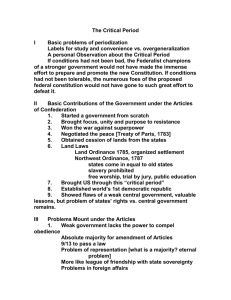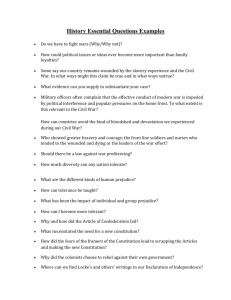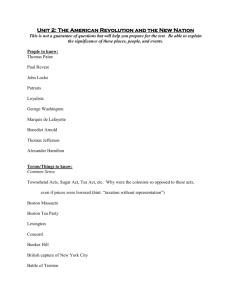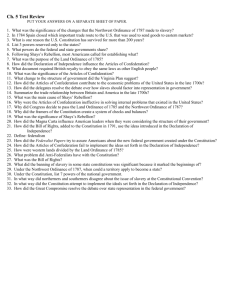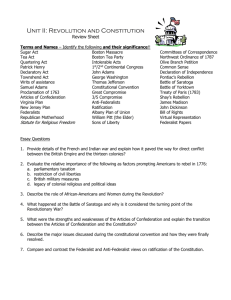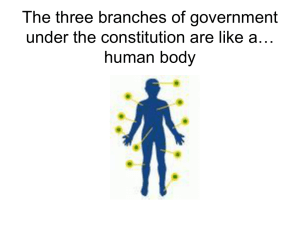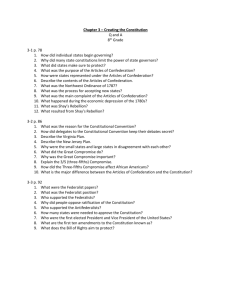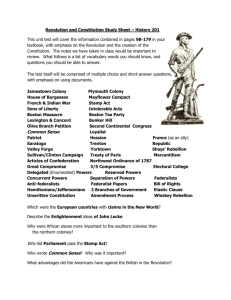Name UNIT 4 – EXPERIMENTS IN GOVERNMENT
advertisement
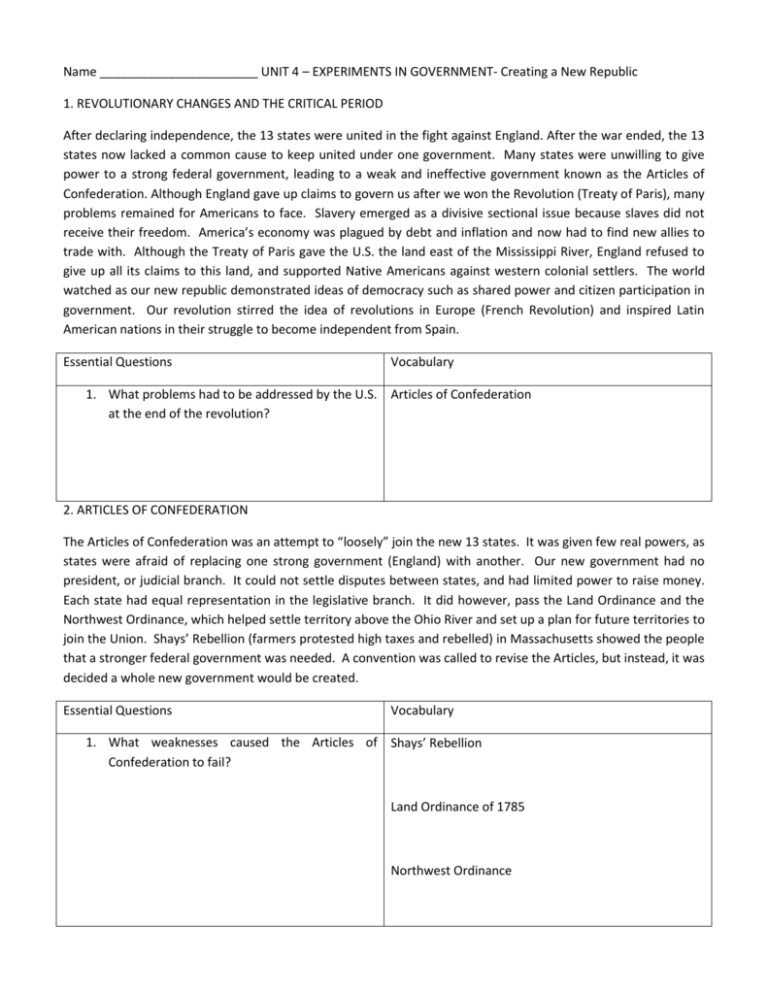
Name _______________________ UNIT 4 – EXPERIMENTS IN GOVERNMENT- Creating a New Republic 1. REVOLUTIONARY CHANGES AND THE CRITICAL PERIOD After declaring independence, the 13 states were united in the fight against England. After the war ended, the 13 states now lacked a common cause to keep united under one government. Many states were unwilling to give power to a strong federal government, leading to a weak and ineffective government known as the Articles of Confederation. Although England gave up claims to govern us after we won the Revolution (Treaty of Paris), many problems remained for Americans to face. Slavery emerged as a divisive sectional issue because slaves did not receive their freedom. America’s economy was plagued by debt and inflation and now had to find new allies to trade with. Although the Treaty of Paris gave the U.S. the land east of the Mississippi River, England refused to give up all its claims to this land, and supported Native Americans against western colonial settlers. The world watched as our new republic demonstrated ideas of democracy such as shared power and citizen participation in government. Our revolution stirred the idea of revolutions in Europe (French Revolution) and inspired Latin American nations in their struggle to become independent from Spain. Essential Questions Vocabulary 1. What problems had to be addressed by the U.S. Articles of Confederation at the end of the revolution? 2. ARTICLES OF CONFEDERATION The Articles of Confederation was an attempt to “loosely” join the new 13 states. It was given few real powers, as states were afraid of replacing one strong government (England) with another. Our new government had no president, or judicial branch. It could not settle disputes between states, and had limited power to raise money. Each state had equal representation in the legislative branch. It did however, pass the Land Ordinance and the Northwest Ordinance, which helped settle territory above the Ohio River and set up a plan for future territories to join the Union. Shays’ Rebellion (farmers protested high taxes and rebelled) in Massachusetts showed the people that a stronger federal government was needed. A convention was called to revise the Articles, but instead, it was decided a whole new government would be created. Essential Questions Vocabulary 1. What weaknesses caused the Articles of Shays’ Rebellion Confederation to fail? Land Ordinance of 1785 Northwest Ordinance 3. THE WRITING, STRUCTURE, AND ADOPTION OF THE U.S. CONSTITUTION After declaring independence from England in 1776, each state had to write its own Constitution outlining the laws and principles of its state. John Jay was responsible for writing New York’s Constitution. Our New York Constitution was written before the U.S. Constitution and may have served as a model. Our state constitution called for 3 branches of government: an executive branch headed by a governor, a legislative branch (bicameral) consisting of the State Senate and State Assembly, and a judicial branch (Court of Appeals is our highest state court). Through a “bundle of compromises” such as the Great Compromise (3 branches of government: one executive, a bicameral legislature [Senate - equal representation, House of Representatives - more people equals more delegates], and judicial branch), and the 3/5 Compromise (every 5 slaves will count as three people, in order to determine a state’s population) a plan of government was ratified. A census is taken every ten years to determine each state’s population. The government set up by the Constitution is a representative democracy (“We the people…”) in which people hold the real power. The personal leadership of Washington, Franklin, Madison, Hamilton and the Federalist Papers (series of pamphlets written to explain why the Constitution should be accepted) helped it gain ratification in 1789. The Constitution is the “supreme law of the land.” Essential Questions Vocabulary 1. How was power divided in the New York State John Jay Constitution? Federalists/Anti-Federalists 2. What compromises were made at the Constitutional Convention regarding James Madison representation in Congress? Ratify Bicameral legislature 3. What was the purpose of the Federalist Republic Papers? Constitution
